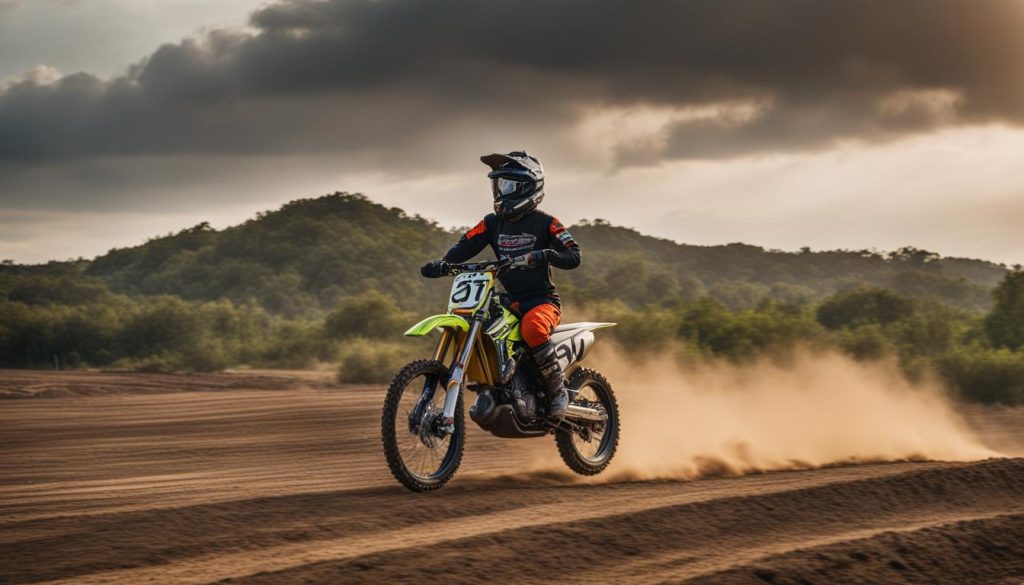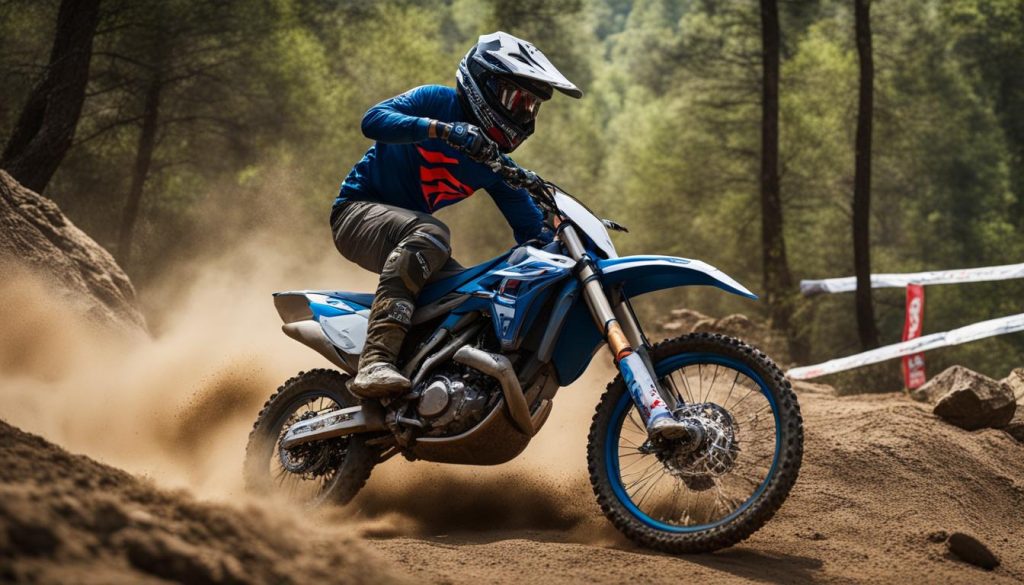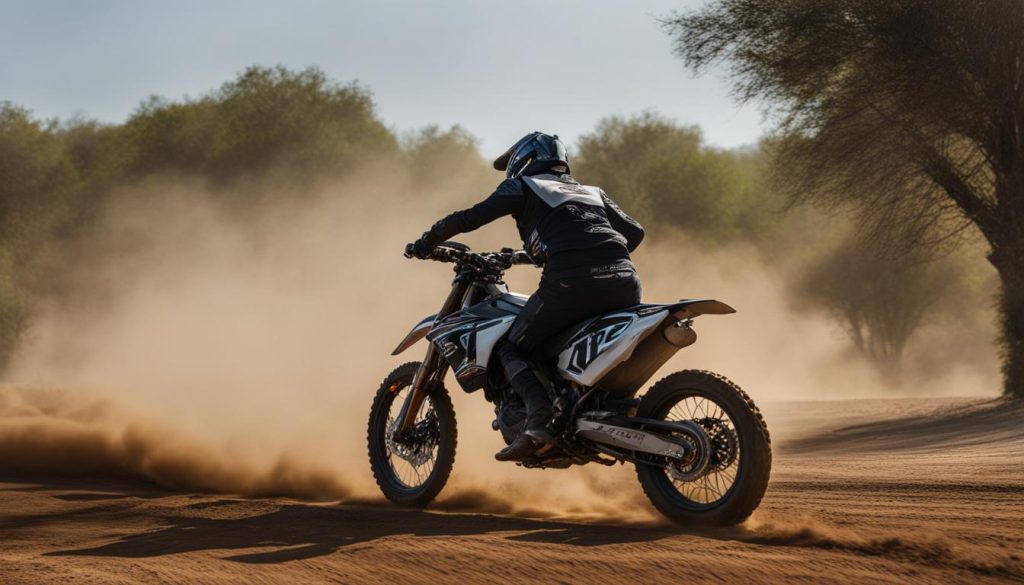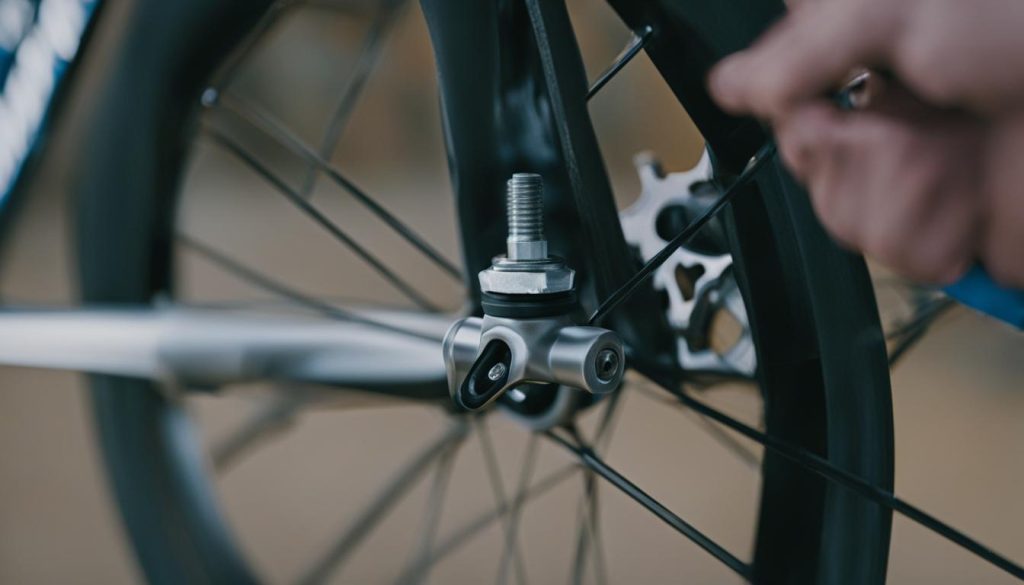Welcome to our comprehensive guide on how to ride a dirt bike. Learning how to ride a dirt bike can be a thrilling and adventurous experience, but it’s crucial to ensure your safety and be equipped with the right skills and knowledge. Whether you’re a beginner or want to brush up on your techniques, we’ve got you covered.
In this guide, we will walk you through the essential steps on how to ride a dirt bike, covering everything from basic riding techniques to important safety tips. You will learn how to ride with confidence, tackle challenging terrains, and have a great time off-road. Let’s begin!
Key Takeaways:
- Dirt bike riding requires appropriate gear, techniques, and safety measures.
- Learning how to ride a dirt bike takes practice, patience, and commitment.
- Following the correct riding techniques can help you ride like a pro in various terrains.
- Safety should be your top priority when riding a dirt bike, so always take the necessary precautions.
- Continuously improve your skills through practice and seek professional training if needed.
Getting Started: Essential Gear and Bike Familiarization
Before we start riding, it’s crucial to ensure that we have the right gear for our safety. Dirt bike riding can be a dangerous sport, so we need to prepare ourselves with the appropriate protective equipment. These include:
| Equipment | Description |
|---|---|
| Helmet | A full-face helmet protects our head and face from injury in case of an impact. |
| Goggles | Protect our eyes from dirt, debris, and other hazards that may affect our vision while riding. |
| Gloves | Provide an excellent grip for our hands and protect them from scrapes and injuries in case of a fall or impact. |
| Boots | Offer ankle support and prevent foot injuries from rocks and other hazards that we may encounter on the trail. |
| Body Armor | Chest and back protectors, elbow and knee guards, and other armor pieces provide additional protection while riding. |
Additionally, before we start riding, we need to get familiar with the different parts of the dirt bike, such as the throttle, brakes, clutch, and gears.
Getting started with the right gear and an understanding of our bike’s mechanics is crucial in ensuring a safe and enjoyable dirt bike riding experience for beginners.
Mastering the Fundamentals: Body Position and Balance
Now that you have the necessary gear, it’s time to focus on mastering the fundamental dirt bike riding techniques that will help you maintain stability and control in various riding scenarios. Achieving proper body position and balance on the bike is key to keeping you safe and in control while riding. Here are some important tips:
Sitting or Standing Position
When riding a dirt bike, you can either sit or stand on the bike. For beginners, sitting on the bike while riding is the safer and more comfortable option. Always make sure to keep your elbows bent, and position your body slightly forward to maintain balance. If you choose to stand, be sure to keep your knees bent and your weight evenly distributed. This will also allow you to absorb shocks, bumps, and jumps with ease.
Weight Distribution
Proper weight distribution is crucial for maintaining balance while riding. As a general rule of thumb, keep your weight towards the front of the bike to maintain balance and control while riding in turns. When riding uphill or downhill, shift your weight forward or backward accordingly. Always keep your core tight and engaged and look where you want to go.
“Achieving proper body position and balance on the bike is key to keeping you safe and in control while riding.”
The key to mastering body position and balance is practice. Start with easier terrain and work your way up to more challenging tracks. This will help build your confidence and enhance your riding skills. As you become more comfortable, you can start pushing yourself to try more advanced techniques.
Ride Like a Pro: Essential Riding Techniques
Now that you have mastered the fundamentals of dirt bike riding, it’s time to take your skills to the next level. To become a pro rider, you need to learn essential riding techniques that will help you maneuver through different terrains and conquer challenging off-road situations. In this section, we’ll cover some of the most important techniques to improve your dirt bike riding skills.
Cornering
Cornering is one of the most crucial techniques to learn when it comes to dirt bike riding. It involves turning the bike while maintaining your speed and balance. The key to successful cornering is proper body position and weight distribution. To take a corner, lean your body into the turn and shift your weight to the outside footpeg. Remember to keep your eyes focused on where you want to go and use the throttle to control your speed.
Braking
Braking is another important technique to master, as it will help you control your speed and stop quickly when needed. To brake effectively, you need to use both your front and rear brakes. Use the front brakes for more stopping power and the rear brakes to control your speed and slide through corners. Remember to apply the brakes gradually and smoothly, and avoid slamming them on suddenly.
Accelerating
Accelerating is all about using the power of your bike to navigate through different terrains. To accelerate smoothly, you need to use the throttle properly. Gradually increase the throttle as you shift your weight forward, while keeping your body in the center of the bike. Use your clutch to shift gears smoothly and maintain control of your speed.
Navigating Obstacles
Obstacles like rocks, logs, and jumps can be challenging to navigate, but with the right technique, you can conquer them with ease. To navigate over obstacles, approach them at a steady pace and use your body weight to lift the front wheel of the bike. Then, shift your weight to the rear of the bike to lift the rear wheel over the obstacle. Use the throttle to control your speed and maintain your balance.
By mastering these essential riding techniques, you’ll have the skills and confidence to tackle any off-road terrain like a pro. Remember, dirt bike riding requires practice and patience, so keep practicing these techniques to improve your skills.

Safety First: Tips for a Safe Dirt Bike Riding Experience
At the heart of dirt bike riding is excitement, but it’s just as essential to prioritize your safety on the track or trail. Follow these valuable safety tips to ensure your riding experience is both safe and thrilling:
- Wear appropriate gear: Always dress in appropriate gear before hitting the dirt. Make sure you wear a full-face helmet, goggles, gloves, off-road boots, and long-sleeved shirts or jackets to stay protected from falls and debris.
- Conduct pre-ride inspections: Before riding, inspect your dirt bike to ensure it is in excellent working condition. Check the brakes, throttle, and tire pressure to minimize the risk of accidents.
- Ride within your limits: Start with simple terrains and gradually work up to difficult ones. Know your limitations and do not take risks beyond your level of expertise.
- Understand trail etiquette: Always obey the trail and riding rules, such as knowing who has the right-of-way and being mindful of other riders’ safety.
Stay Safe, Ride Hard!
By following these critical dirt bike safety tips, you’ll be able to have a safe and enjoyable riding experience. Remember to practice and improve your skills continuously while taking professional training if needed. Get ready to embark on a thrilling off-road adventure, but always put safety first!

Conclusion
We hope this comprehensive guide has helped you master the basics of dirt bike riding. Remember, practice makes perfect! As you continue to ride, you’ll gain more experience and confidence on the dirt bike.
However, always prioritize safety above all else. Stay within your limits, wear appropriate gear, and follow trail etiquette to avoid accidents. And if you’re seeking to improve your skills, consider enrolling in professional training courses.
With the right gear, techniques, and safety precautions, dirt bike riding can be a thrilling and enjoyable adventure. So, gear up, rev up your engine, and hit the dirt!
FAQ
How do I ride a dirt bike?
Riding a dirt bike involves a combination of skills and techniques. To get started, familiarize yourself with the basic controls of the bike, such as the throttle, brakes, clutch, and gears. Next, practice proper body position and balance to ensure stability and control. As you gain confidence, learn essential riding techniques like cornering, braking, accelerating, and navigating obstacles. Remember to always prioritize safety and continuously improve your skills through practice and training.
What gear do I need for dirt bike riding?
Essential gear for dirt bike riding includes a helmet, goggles, gloves, boots, and body armor. A helmet is crucial for protecting your head from potential injuries, while goggles shield your eyes from dirt, rocks, and debris. Gloves provide grip and protection for your hands, while boots offer ankle support and foot protection. Lastly, body armor, such as chest protectors and knee guards, safeguards your vital body parts from impacts and falls.
How can I achieve proper body position and balance on a dirt bike?
Achieving proper body position and balance on a dirt bike is vital for stability and control. When riding, stand up with your knees slightly bent, allowing you to absorb bumps and maintain balance. Keep your elbows up and out to help steer the bike and maintain control. Distribute your weight evenly over the bike to ensure stability, especially when cornering or going over obstacles. Practice these techniques regularly to improve your riding skills.
What are some essential riding techniques for dirt bike riding?
To enhance your dirt bike riding skills, it’s important to master essential techniques. Cornering: Lean your body and bike into the turn, look ahead, and apply throttle smoothly for control. Braking: Use both the front and rear brakes to slow down or stop, ensuring even pressure distribution. Accelerating: Gradually increase throttle to gain speed, especially when exiting corners or climbing hills. Navigating Obstacles: Use your body weight to lift the front wheel over obstacles, and learn to shift your weight to maintain balance on uneven terrain.
What are some safety tips for dirt bike riding?
Safety is crucial when riding a dirt bike. Wear appropriate safety gear, including a helmet, goggles, gloves, boots, and body armor, to protect yourself from potential injuries. Conduct pre-ride inspections to ensure your bike is in good working condition. Ride within your limits and avoid taking unnecessary risks. Understand and follow trail etiquette to prevent accidents and promote a positive riding environment. Finally, consider seeking professional training to improve your riding skills and knowledge of safety practices.





